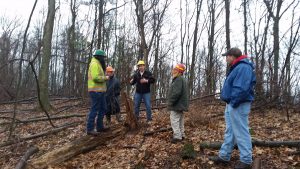Your forestland is an important asset. If you decide to harvest timber from your woods, taking the time to adequately plan the cut will help ensure the harvest will put you on the path to meet your future management goals, and preserve the ecological and economic value of your woods.
In this video, woodland owners discuss their experiences working with wildlife and forestry professionals to ensure a successful timber harvest.
Planning for Success
Prior to cutting any timber, the best first step you can take is to have a forest management plan written for your property (Learn more about why forest management plans are important).
Working with a Professional Forester
 You should also work with a professional forester to discuss your goals for your property, and how a timber sale may help you to meet those goals (Learn more about working with forestry professionals). Your forester should work with you to decide which trees should be removed in the harvest and which trees should be saved to improve the future value of your woods. Your forester should also help you find a skilled logger to remove the trees while minimizing disturbance to the ground and damage to standing trees.
You should also work with a professional forester to discuss your goals for your property, and how a timber sale may help you to meet those goals (Learn more about working with forestry professionals). Your forester should work with you to decide which trees should be removed in the harvest and which trees should be saved to improve the future value of your woods. Your forester should also help you find a skilled logger to remove the trees while minimizing disturbance to the ground and damage to standing trees.
If properly planned, a timber sale can improve wildlife habitat, increase future timber value, and enhance recreational opportunities. Make sure you take the time to identify your objectives, consider your options, and meet with forestry professionals before making a decision that could impact your woods for generations to come.
Additional Resources
Programs like “Call Before You Cut”, which are offered in some states within the AMJV, are great sources of information. Visit our Local Resources page to find organizations in your area that can connect you with local professionals to help you plan for a successful timber harvest.